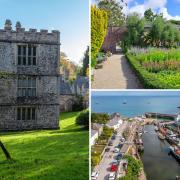Saltash is home to a striking 20-metre sculpture marking Cornwall’s proud heritage and promising future.

Saltash is home to a striking new 20-metre sculpture marking Cornwall’s proud heritage and promising future. SUE MITCHINSON meets Simon Thomas the Polruan-based artist behind the Cornish Cross
Cross the Tamar Bridge into Saltash and you’ll see it above the trees, a vertigris sculpture standing tall; a symbol of Cornwall, infinitely pleasing in structure, vibrant, welcoming.
For the man who conceived it, sculptor Simon Thomas, it’s been an arduous creative process – the result of years of exploration that went before and a milestone on a journey that carries on.
Fourteen years ago Simon won a competition out of 83 entrants from around the world, to create a striking Millennium project. Government funding was unsuccessful but he left his small scale model on show at the town’s Guildhall, a germ of an idea that would one day take wings.

The giant 20 metre (66ft) Cornish Cross was officially launched by TV personalities Richard Madeley and Judy Finnegan, after the The Big Lottery Fund made possible both the sculpture project and the regeneration of the two-acre Elwell Woods where it would be sited. It is a public art work of national significance.
For Simon, focused for some years on smaller scale explorations for scientific research, it was, he says, a chance to get back to my origins, a great big project that I could hit head on.’

Its construction coincided with one of the most difficult periods in his life. His father died of cancer, he separated from his wife, and his mother Joan was close to dying in hospital on the day the Cornish Cross was officially launched.
Now, helping her recover at the family home in Polruan near Lostwithiel, the sitting room full of sunshine and exquisite small sculptures he has made, growing tubs of basil, watching the sea down the hill below or young birds at the feeders outside, working on new structures and designs in his converted garden shed or at the dining room table, he is just starting to re-gather’ himself.
“I need to kick start the creative process again now and see where it takes me.”
This sense of exploration and a powerful desire to engage with the world, marvelling at its infinite richness and complexity – whether watching closely how a gannet dives for a fish in the sea or experimenting with polystyrene balls to understand for himself the geometrical nature of spheres – lies at the heart of Simon’s approach.

It’s what led him to seek out and work with scientists and mathematicians for many years; to follow developments in quantum physics; to seek to understand the nature of structure, of infinity, of the universe. He was a pioneer of what is now termed the Art/Science forum.
“As an artist I am keen to find the truth. Science is the same – through hypothesis, observation, experimentation, scientists boil down what is going on and I love that,” he says. It’s also what I do.”

This has informed most of his working life and led him along completely unexpected paths – from being artist in residence at Bristol University’s Physics Department to delivering a masterclass on creative mathematics to the Royal Institution in London (quite an achievement for someone who just scraped a maths O Level when he was a boy busy fishing and exploring along the River Erme near where he grew up, just twelve miles from the Cross but an outsider’ from the Devon side).
Since graduating from the Royal College of Art in 1988, Simon has completed numerous public and private sculpture commissions, exhibited both in the UK and abroad, and travelled widely as a guest at international festivals and symposia.
“I don’t really like the art world – wherever I can, I sidestep it. I try to express what I see, I do my research with scientists, and I’ve been very lucky to receive funding to progress in this direction,” he says. “Some galleries look down on public art as a compromise, but it’s not true in my experience. No-one ever asked me to make a blue gnome with six fingers. Public art is an opportunity to be part of the world, not isolated and living in a vacuum.”
Working on the Cornish Cross was certainly not an isolated experience. It was a process Simon describes with relish. Just as he points out how a tree by the sea near his home is shaped by the winds to achieve optimum efficiency in its environment, so is sculpture like this shaped by the possible.

He worked closely with David Kendall, of structural engineers Optima Projects, who was based in Dartmouth.
“Everything needed to bind to the three carbon fibre flanks and two rings at the top. It was a lot of work to shift the blocks about, transferring the load all the way up yet with all the breaks, and to hide those massive rings.
“It was a real test of my abilities and my relationship with David. He was brilliant, he had worked on Tornado jets and this was hi-tech - a real engineering feat. I had to alter my design quite a bit but compromise is not a dirty word – nature does it, everything does it to get the optimum, most efficient solution.
“We went through so many scenarios. He had the structural integrity, I had the artistic integrity, it was a brilliant way of working.”

Evolution is one of the most beautiful theories’ Simon wholeheartedly believes, resulting in the best design in nature and in human endeavour. Just as the finest Cornish trawlers built not far from his home are the result of years of refinement, so is the perfection of a dragonfly’s wing.
“With the Cornish Cross we ended up with something I didn’t dream of, getting rid of half the blocks in the head and the body compared to the original design.”
The Cross is not meant to represent Christianity, rather to be symbolic of Cornwall’s heritage on many levels. It is also an exploration of the dynamic and mysterious relationship between spirit and matter - a subject Simon Thomas plans to explore for many more years.
The Cornish Cross
The combined Cornish Cross and Elwell Woods’ regeneration scheme, brought together by Saltash Waterside Residents Association (SWRA) is one of nine flagship projects for The Big Lottery Changing Spaces programme which awarded just over £500,000. Contributions from Cornwall Council and Saltash Town Council, also the Duchy of Cornwall, brought the total budget to £650,000. The Cross itself cost £280,000.
Meaning and materials
The Cornish Cross represents a forward looking, spirited county, proud of its heritage, open to its future. It is constructed from lightweight aerospace/boatbuilding composite materials of glass fibre and carbon fibre, treated with copper powder to give a verdigris effect, and representative of new Cornish industries. The head includes the traditional Cornish-mined metals copper, gold and silver.
Construction and project team
It is 20 metres (66ft) high, weighs two tonnes, and the main shaft has 6,000 individual pieces. It was built in a disused Tornado hangar at RAF St Mawgan (Newquay Airport), by a Cornish team of experts led by Gateguards (UK) Ltd (Cross fabrication) and including Optima Projects (Composite design).
Key project leaders included Joe Ellison (Saltash Town Council) and Liam Bradley (Chairman, SWRA).






























